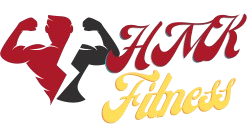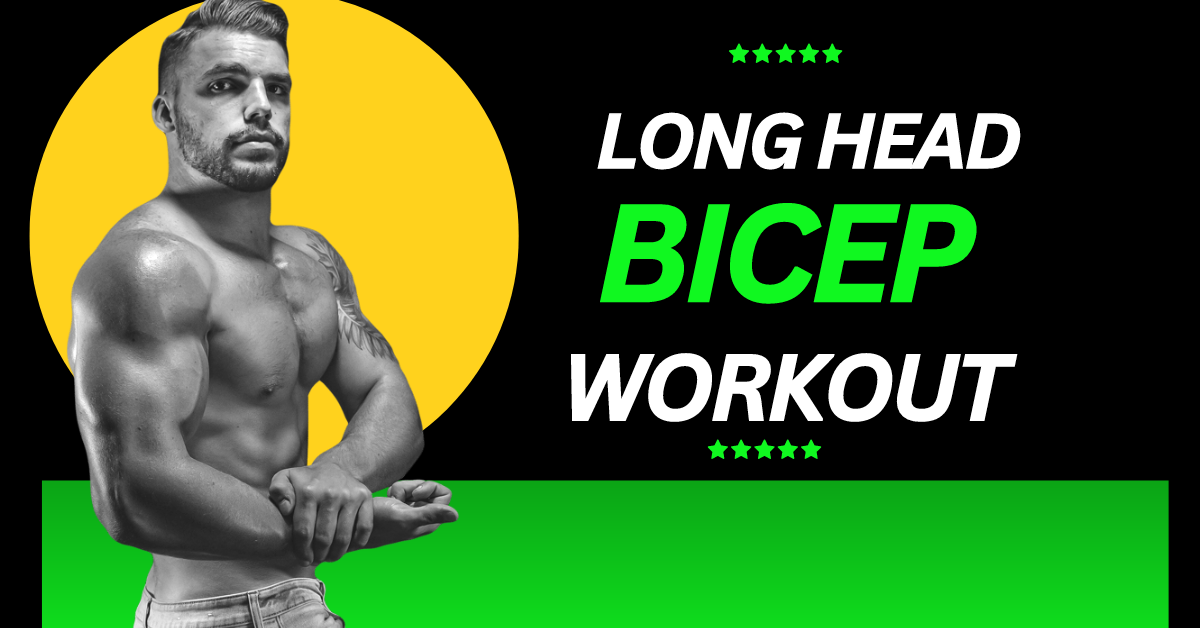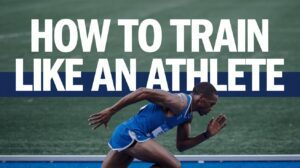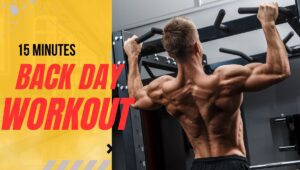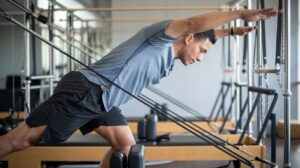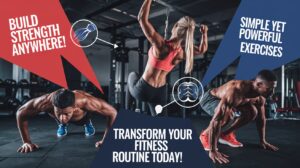In this article, you will learn about long head bicep workouts. To build great arms, the long head of the bicep is crucial in achieving the sharply peaked and full appearance that most fitness enthusiasts work towards. Biceps are two-headed muscles that include a long and short head. Though both heads contribute to increasing your arm size and strength, concentrating on the long one will help you get a more refined aesthetic expression.
This article discusses the anatomy of the biceps, the benefits of targeting the long head, common mistakes in this part of the muscle, and the best exercises to help ensure you effectively engage it. Whether you’re starting or an experienced gym goer, mastering training your bicep’s long head makes all the difference in your overall arm development.
Table of Contents
Toggle2. Understanding the Anatomy of the Bicep:

Appropriately exercising or working out about the bicep’s long head starts with understanding this muscle’s anatomy. The biceps brachii (simply referred to as bicep) is a two-headed muscle situated at the upper arm between shoulder joint and elbow joint. It has two heads, namely;
The Short Head: Positioned on the inside part of an arm, adding width & thickness to the top part, known as Brachialis, which assists in motion flexion,
The Long Head: Found on the outer side of an arm, it helps you attain a peak flexed position when bent, originating from the supraglenoid tubercle of the scapula, attaching itself to the forearm’s radius bone.
Why Focus on the Long Head?
In addition to contributing to the overall size and shape of your arm, a long head plays a very important role in giving more pronounced peaks, thus improving the overall appearance of muscles. Therefore, working out with a focus on these frontiers helps lengthen one’s bicep, resulting in this coveted standard roundness.
- Long Head Bicep: This refers to that section found on the outer side so as to make a curve for the aperture.
- Bicep Anatomy: Comprehending the bicep structure to focus on certain areas.
- Muscle Development: Increasing and improving muscle mass and power.
3. Benefits of Targeting the Long Head Bicep:
Working out your long head during workouts has several benefits that influence how your arms appear and function. This section is critical to target whether you are looking for an improved appearance or aiming to build overall strength.
1. Enhanced Muscle Symmetry:
One of the main advantages of training for the long head of the biceps is symmetry. A well-developed long head brings balance to your upper arms look, giving them a proportional appearance from all views. Apart from visual appeal, this symmetry also aids overall arm muscularity and stability.
2. Greater Bicep Peak:
If you want to get a bicep peak when you are flexing, you will mainly look at the long head. The longer it is, the more it pushes up the muscle and creates that desired peak. This aspect is crucial for bodybuilders or those with arms that need to stand out in casual and competitive environments.
3. Improved Arm Definition:
Also, by targeting the long head of the biceps, one can improve arm definition significantly. Concentrating on this portion of your muscle may get more cut and toned looks. It’s especially useful if one intends to tighten “loose” areas surrounding their thighs while creating muscle separations.
4. Functional Strength Gains:
Training the long head leads to functional strength gains aside from aesthetics only. Strengthening helps improve your performance for pull-ups, rows, and other compound lifts since it involves shoulder stabilization and various pulling actions such as these. This fosters superior overall upper-body stability and strength.
Many
Also Read: 7-Day Meal Plan For Elderly: Try Now!
4. Common Mistakes in Long Head Bicep Training:
Many commonly make mistakes that limit their success even though working with long heads gives them great results. Awareness about these setbacks helps in optimizing workouts, thus leading to better results.
1. Overselling Short Head Exercises:
One big mistake most people often make is overdoing exercises meant to work on short heads of biceps, such as preachers or concentration curls, among others, compared to other exercises targeting long heads, too. Although important, they cannot fully address the issue of elongation as required for full bicep development to reach a peak. This calls for particular exercises of the long head to be included in one’s workout routine if the bicep peak is to be fully developed.
2. Wrong Position:
Another common mistake that people make while performing bicep exercises is using the wrong forms. Such mistakes often occur when you lift quite heavy weights or do not employ the correct muscle engagement. These include swinging the weights around instead of having controlled motions, which will reduce the impact of such long-head biceps formality. The right way to activate the long head is by keeping it activated throughout the range of motion, leading to its better engagement and growth.
3. Neglecting Stretch Position:
The bicep’s long head is most effectively targeted when an arm is fully extended. Nonetheless, many individuals fail at this by not making their arms straight during exercises like incline dumbbell curls. For each rep, ensure it elongates and contracts completely, thus promoting its full participation and improved development.
4. Routine Based Training:
Doing the same biceps exercise repeatedly can lead to no muscle improvement. For effective targeting, the long head requires movement diversity. On a side note, combining different techniques that focus on developing the long head, such as incline and drag curls, prevents stagnation, thereby supporting continuous gain.
- Bicep Workout Mistakes: Common errors that hinder bicep growth.
- Proper Form in Bicep Exercises: Ensuring correct technique for effective workouts.
- Long Head Bicep Training Tips: Advice on how to avoid common pitfalls in training.
5. Top Exercises for Long Head Bicep Development:
Developing the long head of the biceps requires exercises that activate this region in particular. Here are some of the best exercises to help you build up your long head and achieve that desired bicep peak.
Incline Dumbbell Curl:
The incline dumbbell curl is among the top moves for isolating the long head of muscle in arms. Performing it on an inclined bench stretches out more than other bicep workouts, improving engagement.
How to Perform:
- Set an incline bench at 45 degrees angle.
- Sit back with dumbbells in each hand and extend your arms down completely.
- While your upper arm remains fixed, curl up weights.
- At the top, squeeze your biceps and slowly bring them down again to the starting position of the bells.
Drag Curl:
Drag Curl is one of those great exercises that bring out the long head by modifying how you move when doing curls instead of keeping elbows backward, thus increasing the activation of the long head.
How to Perform:
- Stand holding the barbell with your arms straight outwards up above your chest.
- Instead of raising the barbell directly as you curl, drag it up against the torso while pulling your elbows backward.
- Elbows should be pointing behind you at the top motion.
- Return the bar downwards in the same way.
Close-Grip Barbell Curl:
This will target your brachialis – a narrow grip on the barbell during close-grip barbell curl- which is why it is considered a staple movement for any trainee focusing on their long heads.
How to Perform:
- With feet shoulder-width apart, hold a barbell with hands about six or eight inches apart as if close-gripping it.
- Even while bringing the bar upwards toward the chest body, don’t let elbows go away from the sides.
- Squeeze them at the top position, then gradually bring them down to the starting point.
Hammer Curl:
Hammer curls work not only on the biceps but also on the brachialis, a muscle underneath the bicep which pushes the long head upwards and enhances the bicep peak.
How to Perform:
- Stand with dumbbells in both hands, arms stretched out straight, and your palms facing each other.
- While keeping your palms turned inward, curl the weights up.
- At the top of this exercise, squeeze your biceps and slowly move down weight until you get back into this starting position.
Concentration Curl (Modified for Long Head):
A little modification in arm positioning during concentration curls can enable you to target long heads instead of short ones, although they are more suitable for targeting short heads.
How to Perform:
- Sit on a bench with legs wide apart and let your elbow rest inside your thigh.
- Instead of curling the dumbbell directly upward, angle the wrist slightly outward so it focuses more on the head.
- Squeeze at the top and slowly lower the weight back down.
Long Head Bicep Exercises: Specific movements that target the long head of the bicep.
Effective Bicep Workouts: Exercises that enhance bicep size and definition.
Bicep Peak Exercises: Workouts designed to create a prominent bicep peak.
6. Sample Long Head Bicep Workout Routine:
You must have a well-rounded workout plan to effectively target the long head of your biceps with various exercises that work this muscle. Below is a sample routine that may help develop the long head of your biceps.
Warm-Up:
However, before the actual workout, it would be highly beneficial if one warms up their muscles to prevent injuries and prepare them for intense workouts on the biceps.
Warm-Up Routine:
5-10 minutes of easy cardio like jogging or cycling
Two sets of 15-20 reps with lightweight dumbbells for activating biceps
Workout Routine:
Incline Dumbbell Curl:
Sets: 4 Reps: 8-12 Rest: Rest between sets should last about 60-90 seconds.
Directions: Make sure you swing through an entire arc and take your elbows back to lengthen the long head to stretch it maximally.
Close-Grip Barbell Curl:
Sets: 3 Reps: 10-12 Rest: Rest between sets should last about 60 seconds.
Directions: Control each rep, holding at the peak momentary squeeze for full lingering influence on the long head.
Hammer Curl:
Sets: 3 Reps: 10-12 Rest: Rest between sets should last about 60 seconds.
Directions. Keep your wrist neutral throughout the movement to hit both the brachialis muscle and the biceps.
Drag Curl:
Sets :3 Reps:8-10 Rest: Rest between sets should last about one minute. Instructions. Focus on pulling back your elbows and dragging the barbell up your torso, such as fully involving the long head, which is done by drag curling.
Modified Concentration Curl:
Seta :3 Reps:10-12 (one arm) Rest: Rest between sets should last about one minute. Instructions. Slightly turn the wrist away from you to shift the emphasis on the long head of the biceps.
Cool-Down:
Once through with the exercise, cooling down and stretching the biceps is essential to speed up the recovery process and relieve muscle soreness.
Cool-Down Routine:
5 minutes of light stretching for biceps and forearms
1-2 minutes of arm swings (to relax the muscles).
- Bicep Workout Routine: A structured plan for targeting the biceps.
- Long Head Bicep Workout Plan: A specific workout focused on the long head of the bicep.
- Exercise Routine for Biceps: A guide to effectively working out the bicep muscles.
7. Tips for Maximizing Long Head Bicep Growth:
Doing proper exercises alone is not enough to achieve optimal growth in your biceps’ long head. It is an amalgamation of proper technique, nutrition, recovery period, and progressive overload. Here are some vital tips to ensure you get the most out of your workouts targeting your long head bicep muscles.
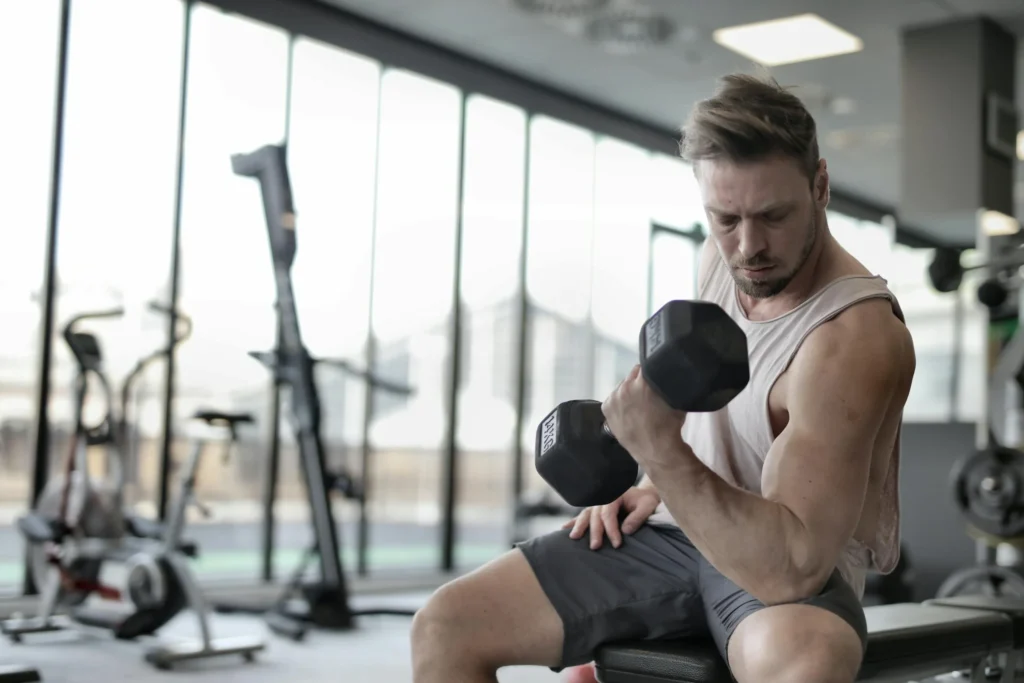

Focus on the Full Range of Motion:
One critical factor determining whether your bicep will grow maximally is using full range motion with every exercise you undertake, such as fully extending and then squeezing them back during each repetition. By this, you guarantee complete involvement of the long head, hence improved activation and muscle growth.
Prioritize Progressive Overload:
The only way to build continuous muscle is by challenging our biceps with either increasing weights or reps over time. Muscles adapt under a state called progressive overload, which increases their strength and size. Always progress incrementally within your training to keep making small gains that eventually lead to muscle increase.
Maintain Proper Nutrition:
Muscle growth isn’t just about what you do in the gym; it also heavily depends on your eating. Therefore, ensure you are ingesting enough protein so your muscles can repair and grow back fast. The diet includes lean protein sources like fish, eggs, plant-based proteins, and chicken. Complex carbohydrates and healthy fats should also be included to provide energy for intense workouts.
Ensure Adequate Recovery:
Rest and recovery are vital for muscle growth. Without proper rest, your muscles don’t have time to heal and become stronger after each exercise. It is upon you to ensure you get enough sleep and take some days off for your muscles to recover. On top of this, incorporate active recovery techniques such as stretching lightly or using foam rollers during a muscle-repairing process.
Vary Your Workouts:
Doing the same movements over time can lead to a plateau regarding muscle growth. Vary your workouts if you want your biceps to be constantly worked out by changing exercises, altering sets and reps, or changing the order of exercises. This will keep your muscles guessing, leading to ongoing development.
Stay Consistent:
It is important for anyone who wants to build their muscles to always remain consistent in whatever they do towards achieving their goal: following their workout routines at appropriate times, eating balanced dieting, and resting appropriately. With time, you’ll see a gradual but steady improvement in growing that long head bicep.
- Bicep Growth Tips: Techniques for increasing muscle size and strength.
- Maximizing Bicep Development: Methods of Maximizing Muscle Growth.
- Muscle Recovery: They grow stronger after damage has been done to them.
8. FAQS:
There are several common questions concerning how best to aim at the long head of the bicep, including some of the following: When it comes down to targeting the long head of the bicep, several common questions arise. Below, we will answer some FAQs about how you can effectively train and develop this vital muscle.
What is the best exercise for targeting the long head of the bicep?
The Incline Dumbbell Curl is a great exercise designed to target the long head more than any other bicep exercise; it helps engage this part more and develop it better with time. This should be done on an incline bench to engage the long head throughout its movement fully.
How often should I train my biceps to see growth in the long head?
To achieve optimal growth, you’re advised to work out your arms, including your long heads, 2-3 times weekly. Ensure you give enough time for your muscles to recover after these sessions. Overdoing it could exhaust your muscles and hinder progress; hence, one needs to find a balance between workout intensity and recovery.
Can I train the long head of the bicep without equipment?
Certainly, training without equipment can still involve exercises like chin-ups, which utilize one’s own body weight. Chin-ups, particularly with a close grip, effectively engage the long head of the bicep. However, if targeted muscle growth or improved outcomes are desired, including dumbbells or barbells is suggested.
How long does it take to see noticeable growth in the long head of the bicep?
It typically takes several weeks or even months for the visible development of a well-trained person’s brachialis muscle, depending on where they start and their workout intensities. To facilitate quicker muscle growth due to consistency, what matters most includes proper nutrition and progressive overload during workout sessions.
Should I consistently lift heavy weights to build the long head of the bicep?
While heavier weights can aid muscle growth, correct form and a full range of motion are more important than just lifting heavy. Begin with a weight that allows you to execute each exercise with strict form, then gradually increase the weight as you get stronger.
Can I target both the long head and short head of the bicep in one workout?
Truly, you can and should address both parts of your biceps in a single workout for an even development. When you incorporate workouts that involve both types of muscles, your body will have symmetrical arm muscles, which will be well-proportioned.
Bicep Workout FAQs: People ask questions about exercises for their biceps and what helps them grow big and strong.
Long Head Bicep Questions: Queries concerning specific features of the upper arm muscle’s long (upper) part.
Bicep Training Tips: Recommendations on effective training routines, including arm workouts.
